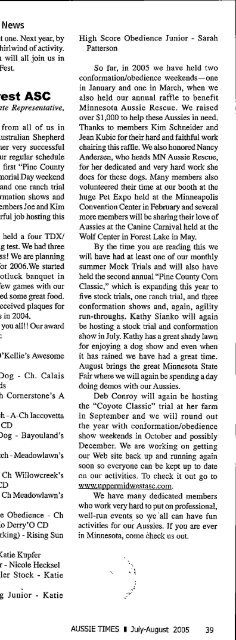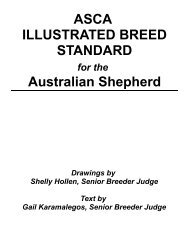You also want an ePaper? Increase the reach of your titles
YUMPU automatically turns print PDFs into web optimized ePapers that Google loves.
Q&A<br />
BINGO!<br />
Understanding Polygenetic Inheritance<br />
Originally published in the fall 2004 issue of<br />
Double Helix Network News. Reprinted by<br />
permission ofthe author, C.A. Sharp.<br />
Everyone knows this old game: You<br />
place beans or other markers on<br />
numbered squares arranged in a<br />
grid as someone announces numbers pulled<br />
at random from a box. The first person to<br />
form a line of markers across the grid in<br />
any direction yells, "Bingo!"<br />
Breeding dogs is like playing Bingo,<br />
but instead of arranging beans on a card<br />
you are shuffling genes. When the right<br />
combination lines up, one or more of<br />
the puppies in your litter may exhibit a<br />
polygenetic trait: Bingo!<br />
Polygenetic traits are probably the<br />
most difficult for breeders to understand.<br />
They are certainly the most difficult to<br />
control in a breeding program, whetheryou<br />
want the trait or you don't. The phenotype<br />
of the dog—what you see or the behavior<br />
you get—will spring from the combined<br />
actions of multiple genes. Sometimes, as<br />
with hip dysplasia, the genetic potential<br />
may be swayed by environmental effects.<br />
Unfortunately, many inherited<br />
diseases, like HD, are polygenetic. It<br />
follows an irregular inheritance pattern:<br />
Some dogs will never produce HD, others<br />
may produce it occasionally, and some<br />
will produce it frequently. Some families<br />
will have it every generation, others may<br />
go for several generations with no cases at<br />
all. Excellent hips may produce dysplastic<br />
and affected parents may produce sound<br />
offspring.Whether a dog will produce HD<br />
ornot dependsonexactlywhatcombination<br />
of genes it has and who it is bred to. Even<br />
though the environment plays a role, a dog<br />
won't have HD unless it has the genes to<br />
do so.<br />
Thinking of the different genes that<br />
contribute to polygenetic traits as letters in<br />
the word BINGO may help you visualize<br />
whathappens as they are passedfrom one<br />
generation of dogs to the next. For the<br />
sake of this discussion we will say that to<br />
produce a polygenetic trait, the dog must<br />
have particular alleles—or versions—of<br />
five different genes before it will have that<br />
78 AUSSIE TIMES I <strong>July</strong>-<strong>Aug</strong>ust <strong>2005</strong><br />
trait. We will call them B I N G and O.<br />
If a dog has any combination of alleles at<br />
those genes other than BINGO, it will not<br />
exhibit the trait. BINGo won't do it and<br />
neither will BInGO. Dogs like these with<br />
an incomplete set are carriers of the trait,<br />
but they will only produce it if mated to a<br />
dog with the missing alleles.<br />
You can breed BiNGO to BiNGO and<br />
never see the trait, but cross once to a dog<br />
that has I rather than i and there may be<br />
BINGO puppies. Obviously, a dog with<br />
only one BINGO allele will produce the<br />
trait far less often than one that has all but<br />
U 26<br />
one ofthem. In fact, a dog that just has just<br />
U might never be bred to one that has BINU<br />
and therefore never produce the trait even<br />
though it is a carrier.<br />
Though we don't think of it as such,<br />
coat color results from action of multiple<br />
genes. Some determine color (black, blue,<br />
yellow.) Others provide pattern (brindle,<br />
piebald, merle) The particular combination<br />
of color gene alleles determines what color<br />
dog you have. For example, an acceptably<br />
colored blue merle Australian Shepherd<br />
with tan points would have a genotype<br />
that could be described thus: a'- B- C-<br />
D- E- gg kk Mm s'-. Some genes must be<br />
dominant, others need two recessives. The<br />
ones with one allele and a dash may have<br />
two different alleles, provided that least one<br />
is the allele noted and the other is the same<br />
or recessive to it. Change a single allele<br />
and you canhave an entirelydifferentcolor<br />
dog: A pair of m's makes the dog a black<br />
tri; a dominant K deletes the tan points.<br />
Maintaining desirable polygenetic<br />
traits is easier than getting rid ofthem, but<br />
even so you can breed a BINGO pair and<br />
windup withadudlitter. Diligentselection<br />
for BINGO over many generations may<br />
ultimately lead to the trait becoming very<br />
common. Even so, the occasional non-<br />
bingo pup will occur because of a chance<br />
combination of the non-bingo alleles<br />
floating around in the gene pool in low<br />
frequency.<br />
Completely eliminating a polygenetic<br />
trait can be extremely difficult if not<br />
impossible. If ancestors of your dog have<br />
produced an unwanted BINGO, some or<br />
all of the genes may come down to your<br />
dog. If Lucky is heavily linebred on the<br />
Old Granddad/Grandma cross and Gramps<br />
and Granny were known to have produced<br />
BINGO, there's a fair shot Lucky will carry<br />
at least some ofthe genes even if he doesn't<br />
N<br />
63<br />
have the trait himself. The more ancestors<br />
that have had or produced BiNGO and the<br />
closer up they are in the pedigree, the more<br />
likely Lucky will at least be a carrier.<br />
Unfortunately, there is much we do not<br />
know about polygenetic diseases. Some<br />
don't start until the dog is an adult and<br />
may already have been bred. Sometimes<br />
diagnosis is not clear-cut. We may not<br />
be able to predict which cases will be<br />
controllable and which will be crippling<br />
or lethal. And in most breeds we can only<br />
guess at the specifics of inheritance. While<br />
it is possible withcareful,diligentselection<br />
over generations, to clear a line of a trait,<br />
its absence doesn't mean that you have<br />
eliminated BINGO. Maybe you have only<br />
eliminated G.<br />
A common breeder's dilemma is<br />
the discovery that one of your dogs is<br />
half-sibling to a dog with an undesirable<br />
polygenetic trait.Withhalf-sibs, youknow<br />
that the common parent had some part of<br />
BINGO. Therefore, your half-sib probably<br />
inherited something. Depending on what<br />
genes the half-sib's other parent has, it<br />
mayhavepicked upafewmore—possibly<br />
enough to have BINGO. Even without a<br />
complete BINGO it is a carrier. If you are<br />
going to breeda half-sib, the otherside of



